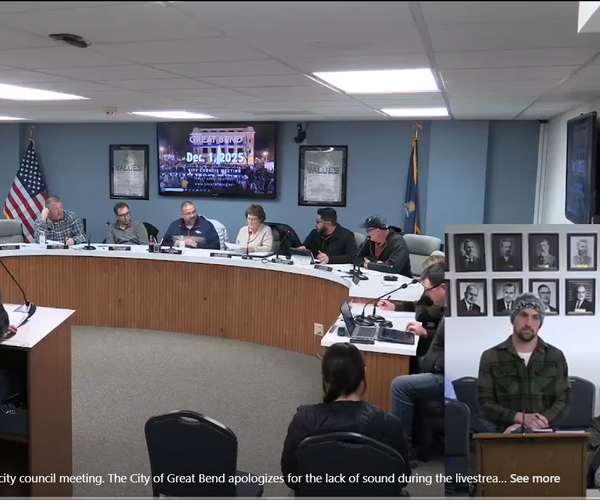A half century ago, Barton County Rural Water District 1 was formed to serve a small territory just north of Hoisington. Now, it wants to join forces with the sprawling Russell County Rural Water District 3 in a multi-million plan allowing Hoisington to sell water to Bunker Hill, replace aging infrastructure and eventually allowing the districts to merge.
This is a costly undertaking, said BCRWD No. 1 Secretary/Treasurer Mary Anne Stoskopf. She came before the Barton County Commission Wednesday morning seeking $130,000 in county money to help with what is a nearly $1 million project.
“Today, Barton County rural Water District Number One is requesting an investment in the future of Barton County,” Stoskopf said. “This is a significant opportunity to have a impact on the future of our county.”
But, while appreciative of the need for improvements, commissioners were leery of offering the full amount. Also on Wednesday, they considered funding to help the City of Ellinwood with water improvements, matching funds for a recycling grant in Claflin and assistance for Sunflower Diversified Services’ glass recycling program.
They are also starring at the cost to replace the heating and air conditioning in the Courthouse.
So, the commission split the difference, offering BCRWD No. 1 $65,000, contingent upon it matching the contribution and securing necessary agreements with all participating parties. The county will tap its federal COVID-19 American Recovery Plan Act money for the funding.
District 1 Commissioner Kirby Krier said there are individuals looking at building new homes within the Barton County district. “There is a very good possibility without this infrastructure that these three new homes may not have been put in.”
Project details
The requested funding will go towards a $900,000 project that involves installing new pipe to connect Hoisington to the district, and connect the district to the Russell County district. This would tie into RCRWD 3’s $7.2 million project which is going to be breaking ground on sometime soon.
“The larger (new pipeline) project will serve nearly 800 Barton county residents, including the towns of Odin, Beaver, Susank and Galatia, and rural residents in more than 11 townships in Barton County,” she said. The RCRWD 3 currently serves 11 Barton County townships.
In addition to the southern portion of Russell County, Susank-based RCRWD No. 3 takes in much of northern Barton County, including Olmitz and Susank, as well as portions of Ellis and Rush counties.
Russell County Rural Water District 3 has been pre-approved for a $900,000 loan from the Kansas Revolving Water Found for this project, she said.
The Barton County district will provide the easements that will allow RCRWD No. 3 to purchase water from Hoisington and sell it in bulk to Bunker Hill, which has a radium contamination issue with its current water supply. The initiative also includes the replacement of the 50-year-old infrastructure of Barton County 1.
And, as required by state law, BCRWD No. 1 will eventually ask the commission approval when it is absorbed by the Russell County district.
There were questions from commissioners asking if the Barton County District had sought other funding sources before reaching out to the county.
Stoskopf had contacted Dodge City-based Great Plains development Inc. In a reply letter to Stoskopf, the economic development agency noted the only grant funding they were aware of was through the American Rescue Plan Act funds received by the county.
In addition, the Kansas Department of Commerce has temporarily suspended its community development block grant program and the United States Department of Agriculture had no Rural Development funds available, Krier said. “I applaud them for at least attempting to get in there.”
Stoskopf said they had first approached the commission a year ago about this. She admitted had they known about the Great Plains possibility then, they might have taken advantage of it.
She, along with the commissioners agreed there is a need for clearer communication between all parties.
Strained resources
“Water is the most important” resource for the entire county, District 2 Commissioner Barb Esfeld said. “It will take a long time for taxes to pay that $130,000 back, but we do realize the importance of it. And we don’t want our other citizens to suffer.”
But, when the district first came to the commission last year, commissioners didn’t realize how much it would cost to replace the Courthouse heating and air conditioning.
“That’s where I started to have heartburn, That’s where it started to cause me concern in even giving it (funding to the district),” she said. “It isn’t that I didn’t want to help. It was great and it was perfect, but then you start looking at $20,000 here, $130,000 here and $300,000 here, and then are we going to have to cause our own taxpayers grief on our own project that we’ve got going.”
“I agree wholeheartedly with Barb,” Krier said. “What we have to do is watch out for that money that we don’t spend beyond ARPA money and don’t have to start going into our reserves that property tax have built up.”
It was asked if the City of Hoisington would contribute to the cost of the project.
The answer was no, since it is being paid for the water sold to Bunker Hill. But, they are contributing via the additional use of their water utility, which city officials have said can handle the extra load.
For now, Hoisington will charge the same rate for the additional customers as it charges for the water to BCRWD No. 1 customers, Stoskopf said.





